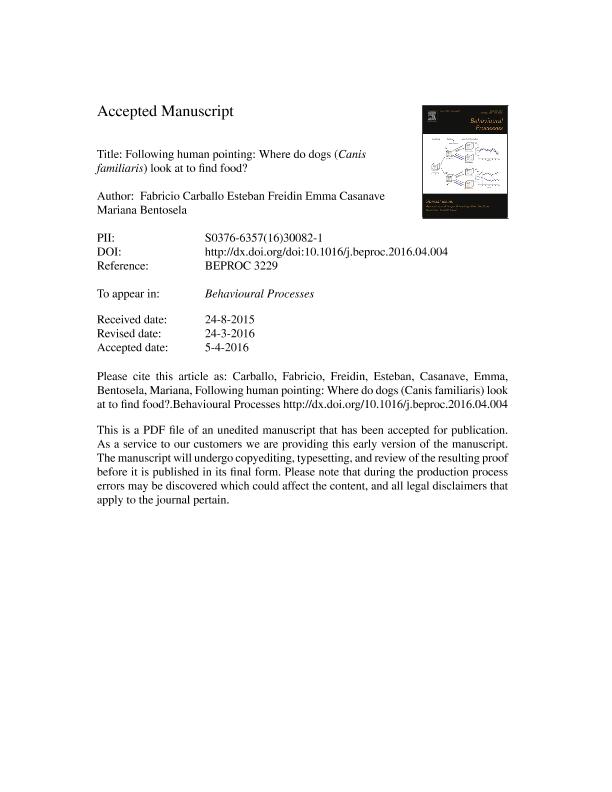Artículo
Following human pointing: Where do dogs (Canis familiaris) look at to find food?
Fecha de publicación:
07/2016
Editorial:
Elsevier Science
Revista:
Behavioural Processes
ISSN:
0376-6357
e-ISSN:
1872-8308
Idioma:
Inglés
Tipo de recurso:
Artículo publicado
Clasificación temática:
Resumen
Domestic dogs (Canis familiaris) are notably skillful in following cues from people (e.g., pointing gestures). However, not much is known about the processing of information available during such tasks. We here focus on one of the earliest of such processes, namely attention. The goal of the present work was to describe variations in dogs’ attention towards diverse targets while they solve an object choice task with human pointing. The direction of subjects’ gaze was measured in the period comprising one second before and two seconds after the experimenter called the dog and simultaneously performed a static distal pointing gesture towards the correct bowl. We did two consecutive training phases: acquisition and extinction. Dogs spent more time watching the pointer than the pointing gesture itself and the correct than the incorrect bowl. Indeed, the time spent watching the correct bowl was the best predictor of correct choices across phases. We discuss the relevance of these findings for the process of local enhancement.
Palabras clave:
Attention
,
Dogs
,
Gaze Direction
,
Object Choice Task
,
Pointing
Archivos asociados
Licencia
Identificadores
Colecciones
Articulos(IDIM)
Articulos de INST.DE INVEST.MEDICAS
Articulos de INST.DE INVEST.MEDICAS
Articulos(IIESS)
Articulos de INST. DE INVESTIGACIONES ECONOMICAS Y SOCIALES DEL SUR
Articulos de INST. DE INVESTIGACIONES ECONOMICAS Y SOCIALES DEL SUR
Articulos(INBIOSUR)
Articulos de INSTITUTO DE CIENCIAS BIOLOGICAS Y BIOMEDICAS DEL SUR
Articulos de INSTITUTO DE CIENCIAS BIOLOGICAS Y BIOMEDICAS DEL SUR
Citación
Carballo Pozzo Ardizzi, Fabricio; Freidin, Esteban; Cassanave, Emma; Bentosela, Mariana; Following human pointing: Where do dogs (Canis familiaris) look at to find food?; Elsevier Science; Behavioural Processes; 128; 7-2016; 37-40
Compartir
Altmétricas




